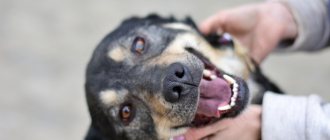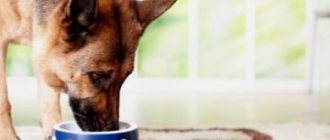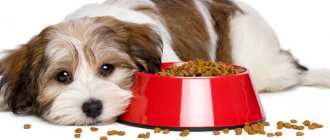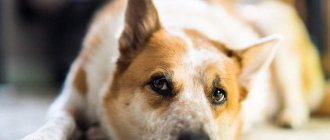Constipation refers to the infrequent passage of dry, hard stool. If bowel movements are delayed and feces remain in the colon for two or three days, the colon removes too much moisture from the material, making elimination difficult and painful.
A constipated puppy may squat for long periods of time and strain unproductively. Persistent constipation can lead to loss of appetite and the puppy losing weight or not gaining the desired weight.
If the condition becomes chronic, the puppy's intestinal lining may become inflamed, stimulating the production of mucus, or a dark liquid that accompanies the stool.
Sometimes it can be confused with diarrhea. Although constipation is more common in older dogs, learn why and how to treat it in your pup and when to visit the vet.
When to talk about constipation
You should think about treating constipation in dogs only when bowel movements have not been observed for several days. Depending on the severity of the condition, bowel movements may be completely or partially absent.
Adult dogs defecate 1-2 times a day, older dogs - once every two days, and puppies - up to 5 times a day. This is explained by the metabolic rate, which reaches its maximum at an early age.
In addition to frequency, it is important to consider the appearance of the feces. The feces of a healthy animal have an oblong shape, soft consistency and dark brown color. Failure to comply with at least one of the points is a serious cause for concern.
List of laxatives
A list of pharmaceutical drugs to combat constipation is presented.
| Name | Peculiarities | Price |
| Magnesia | Attracts liquid and has a strong peristaltic effect. Dilute in boiled water at the rate of 1-2 g of powder per 1 kg. | From 60 to 150 rubles. |
| Bisacodyl | Increases the volume of mucus in the intestines. Release form: tablets, rectal suppositories. | From 40 to 100 rubles. |
| Vetelakt | The growth of beneficial bacteria in the intestines is stimulated, and the “water content” of stool increases. Helps with long-term constipation. Dose - 2-3 ml per 10 kg. | 80-150 rub. |
| Senade | Used for symptomatic treatment. The tablet form is suitable for animals.
| 50-100 rub. |
| Vetasyl | dietary supplement Contains barley and plantain. Dosage - 1 capsule per 9 kg of weight. Sprinkle the animal's food. | 100 capsules - 1600 rub. |
Symptoms of constipation in dogs
Problems with stool quickly affect the emotional state of the pet. He becomes restless, loses his usual cheerfulness and refuses to play. Soon other symptoms and signs of constipation in the dog appear, confirming the concerns:
- bloating, hardening and rumbling of the abdomen;
- loss of appetite;
- pain when palpating the abdominal cavity;
- frequent but unsuccessful attempts to defecate, accompanied by whining;
- the appearance of vomiting and fever;
- reducing the volume of feces, drying them out and compacting them.
If the intestinal walls are severely damaged, the stool will contain blood particles. In this case, it is better to entrust treatment to a veterinarian.
Prepare before going to the vet
In the office, you may have to provide the veterinarian with all possible assistance (hold the animal while they take blood for analysis, give an injection, extinguish aggression, calm your voice, scratch its ears, stroke it). If you know that you are terrified of blood, IVs, or definitely cannot withstand the type of medical interventions, then perhaps you should ask a friend or relative for help.
Find a veterinary certificate, veterinary passport.
Take:
- Leash;
- Collar;
- Muzzle;
- Carrying;
- A pack of napkins;
- litter;
- Bowl, water (at the veterinarian's discretion)
Prepare answers to possible questions from the veterinarian:
- Are all vaccinations up to date on the animal?
- Pet’s behavior in recent days, appetite;
- His diet;
- What drugs and medicines did you give to the animal;
- Latest test data (if available).
It’s better to make an appointment in advance - you’ll save time and be able to calculate when you’ll have to take time off. This does not apply to life-threatening situations where you will have to take an animal to a veterinary clinic without an appointment.
https://dog-care.ru/zdorove/bolezni/zapor-chto-delat-v-domashnih-usloviyah.html
Be affectionate with your pet, play, talk to him. You can take his favorite toy with you so that while you wait for your turn at the reception, you can distract your friend from the new environment.
Furry, feathered or scaly ones also need to be prepared. No matter how much you want to treat your little one with something tasty, remember: you need an empty stomach. Feeding is prohibited!
You can wash your animal without using detergents. But it is important not to touch your pet if there is nasal discharge, watery eyes, salivation (salivation), dandruff, scratching, rashes, skin scabs, loss of hair/feathers/scales, wounds and other external manifestations of a potential disease.
If the veterinarian has instructed, collect the animal’s urine in a sterile container, and pick up the feces with a stick (no blades of grass, specks, or debris). Transfer the feces into a sterile container. Send to the biochemical laboratory within 6 hours. The feces are examined for eggs of roundworms, pinworms, tapeworms, liver flukes, echinoccus, alvecoccus, pork tapeworm, bovine tapeworm, and gastrointestinal bleeding is detected.
At the veterinary hospital, the animal’s blood will be analyzed for antibodies to allergens, viruses, bacteria, and parasites.
Possible causes of the problem
You can find out how to treat constipation in a dog only after identifying the cause. Delayed defecation is only a consequence, not an independent disease. In addition to improper nutrition and care, disturbances in the outflow of feces are provoked by parasitosis, physiological and even psychological factors.
The risk group includes pregnant pets. In addition to changes in hormonal levels, the cause is an enlarged uterus, compressing the intestinal loops.
Elderly age
In addition to a slowdown in metabolism, aging is accompanied by a decrease in muscle tone and deterioration in peristalsis. The problem that has arisen is aggravated by compassionate owners who reduce the “old man’s” usual activity and pamper him with previously forbidden delicacies.
Infection with worms
The accumulation of helminths narrows the lumen in the intestines, disrupting its patency. Parasites also cause damage to the mucous membranes, causing irritation.
Foreign bodies in the intestines
Puppies are guilty of swallowing foreign objects because they want to try everything they see. Stuck pieces of wood, toys or stones block the exit of feces.
Poor nutrition
Delayed bowel movements occur when feeding a puppy with goat's or cow's milk. Instead, it is recommended to feed a motherless baby with ready-made milk formulas for dogs.
When feeding high-quality dry food, the intestines work uninterruptedly. The opposite situation is observed in animals that eat natural products. Intestinal disorders are explained by a lack of fiber, consumption of prohibited foods (these include sweets, processed foods, flour, spicy foods) or a high-protein diet.
Binge eating
Excessive amounts of food are not used for daily energy production and are stored as fat. The body does not have time to cope with such volumes, so food particles settle on the intestinal walls. Over time, they dry out and harden, interfering with emptying.
Physical inactivity and excess weight
Physical inactivity is a small amount of activity. It occurs in animals that rarely go outside and in overweight pets. Excess fat deposits are detrimental to internal organs. The removal of feces is complicated due to compression of the intestine.
Short or too leisurely walks slow down peristalsis. The number of intestinal contractions decreases, which leads to congestion and blockage of the gastrointestinal tract.
Gastrointestinal injuries from eating bones
Constipation in a dog after eating bones occurs due to gastrointestinal trauma. Small and sharp bones of river fish are especially dangerous. If severely wounded, they can cause death from blood loss.
Long and thick coat
Pets with long and thick hair require more careful care. Infrequent brushing of fur provokes frequent licking and leads to the accumulation of fur in the intestines. Hairballs, called trichobezoars, block the path of feces. Defecation is also complicated when tangles appear near the anus, blocking the passage from the outside.
Consequences of treatment
Often, stagnant processes are explained by a recent operation or prolonged use of medications. In the first case, the decrease in the tone of the intestinal walls is associated with anesthesia, and in the second - with antibiotics, iron-containing and astringent drugs that have a detrimental effect on the microflora.
Dehydration
Lack of fluid prevents the smooth passage of stool. Hardened feces begin to injure the mucous membranes, causing a reflexive contraction of the anus.
This problem is especially relevant for animals that eat dry food. Processing pellets requires a lot of water. If the amount of fluid entering the body is too small, then reserves are replenished directly from the feces.
Prevention
It is best, of course, not to treat, but to prevent the problem. To do this, you must adhere to the following rules:
- Follow the rules and feeding regimen. The dog's diet should be balanced: the presence of vegetables, fruits (fiber promotes proper digestion). Feeding exclusively meat products, strong broths, and lack of fiber will lead to the dog constantly suffering from constipation. If you don’t know what to cook for your pet, then I suggest you look at these simple recipes for food for dogs.
- You should not feed your dog small bones, especially poultry bones, because eating bones can lead to constipation. Read about what bones you can sometimes give to dogs.
- Avoid foods that cause flatulence in your diet.
- Introduce supplements into your four-legged diet in the form of seaweed, fish oil, olive or sunflower oil.
- Your pet should have easy access to water at all times.
- Walk your pet more often.
- Load it with active physical activity. But do not forget that you cannot do this immediately after eating.
- Carry out preventive vaccination and deworming.
If you follow these simple rules for keeping an animal, your dog will be less likely to become constipated.
Take care of your pets!
What can you do if your dog is mildly constipated?
Self-medication is permissible only if the delay in defecation is no more than 3 days. The pet's condition must be satisfactory. Otherwise, it is safer to go to a veterinary clinic.
Vaseline oil
If it is not possible to ask your doctor what to do if your dog is constipated, you can use Vaseline oil at home. This is the safest stool thinner. It is not absorbed by the body, which means you won’t be able to overdo the dosage.
To alleviate your pet's condition, pour Vaseline oil into the mouth, close his jaws and hold them for a while. Gradually, the medicine will reach the intestines through the esophagus, lubricate its walls and exit through the anus.
The dosage is calculated by weight: 1 ml of oil is used per 1 kg of animal weight.
The medicine is given twice a day until the usual bowel movements return. The first improvement occurs within 5 hours after injection. Vaseline oil is contraindicated during pregnancy, inflammation of the peritoneum and intestinal obstruction.
Enema
Vaseline oil is infused not only orally, but also through an enema. In this case, the effect appears within 5-15 minutes. The basis of the enema is water. In addition to Vaseline, glycerin, chamomile decoction, soap solution or fish oil are added to the enema. The volume of liquid is calculated depending on the size of the animal:
- 1 liter with a weight over 40 kg;
- 0.5 l with a weight of 20-40 kg;
- 0.2 l with a weight of less than 20 kg.
If the pet is less than 1 year old, then the amount of liquid is reduced to 1 tablespoon, and all additional impurities are excluded. Despite its effectiveness, the procedure is contraindicated if:
- severe dehydration;
- injuries or neoplasms in the gastrointestinal tract;
- pregnancy;
- high temperature;
- frequent vomiting;
- increased breathing and pulse;
- the slightest suspicion of intestinal obstruction;
- kidney or heart diseases;
- bleeding from the anus.
Due to so many restrictions, it is best to entrust the enema to a veterinarian. When introducing liquid yourself, watch its entrance into the anus. If it flows out and does not pass through the anus, stop the procedure and urgently take the animal to a veterinary clinic. This condition is typical for intestinal obstruction, which can lead to intestinal rupture.
Folk remedies and methods
Among folk remedies, it is recommended to use kefir, oat or flax infusions and products with a laxative effect (beets, prunes, plums, fresh carrots). To get the desired effect, consider the size of the animal. A small breed dog needs a couple of teaspoons of kefir, but a large dog will need a whole glass.
To prepare the infusion, pour 1 tbsp. l. oat or flax grains 100 ml boiling water. Infuse the resulting mixture for an hour and dispense twice a day before meals.
Main symptoms: how to understand that you need help
There are several symptoms that indicate your pet is constipated . A responsible owner will immediately notice if his dog does not go to the toilet during a walk or if something is wrong with him. However, there are several other obvious signs that indicate that your pet will need specialized help:
- The pet tries to go to the toilet several times without any visible result;
- It is worth paying attention to the dog’s behavior: it stops eating and drinking, indifference and apathy towards everything prevails;
- Due to the accumulation of gases, the abdomen becomes dense and bloated;
- The dog has not had a bowel movement for more than 24 hours;
- If the animal still managed to go to the toilet, then the feces will be much less than usual, it will be dark and dry.
In severe cases, constipation may be accompanied by vomiting, due to the onset of intoxication of the body with toxins. If bloody impurities, pieces of undigested food and foam begin to appear in the stool, you need to urgently contact a veterinarian . The stool may also have a putrid and damp odor.
When to call a doctor
The alarm should be sounded if the dog cannot go to the toilet for 2-3 days. It is important to consult a doctor for advice. Constipation can be not only an independent pathology of the intestinal tract, but also a symptom of serious diseases: intestinal obstruction (caused by the absorption of inedible objects or the formation of tumors) or coprostasis (constipation of extreme severity). In the first case, the dog experiences vomiting, abdominal pain, and apathy. In the second - bloating, severe pain, intoxication and vomiting.
When to see a doctor
If there is a prolonged absence of defecation and the effect of home treatment, if alarming symptoms appear, the pet should be taken to the veterinarian. After diagnosis, the doctor will tell you what to give your dog for constipation and determine whether surgery is necessary.
Alarming symptoms
If there is no stool for more than 2-3 days, the animal must be examined at a veterinary clinic. The accumulation of feces leads to severe intoxication, so delay can be disastrous.
Poisoning is accompanied by constant weakness, fever, repeated vomiting and severe dehydration. Lack of water is noticeable by sunken eyeballs, dry gums and nose. No less alarming is the appearance of blood or undigested food particles in the feces, as well as their putrid odor.
Procedures at the veterinary clinic
To determine the possible cause that affected the four-legged patient’s condition, the clinic takes his blood test, performs an ultrasound and x-ray. These studies help identify concomitant diseases, detect parasites or foreign objects.
Depending on the diagnosis, treatment can be medicinal or surgical. Taking laxatives and administering enemas is limited to small fecal accumulations. If a foreign body or intestinal obstruction is detected, the patient is scheduled for surgery. After all procedures have been completed and the pet’s condition has been stabilized, the pet is sent home and prescribed a therapeutic diet.
What laxatives will the vet prescribe?
All laxatives affect the body differently, so never prescribe them yourself. Medicines from the human medicine cabinet are especially dangerous for animals - they actively stimulate smooth muscles, which can cause rupture of the intestinal walls. These laxatives include Bisacodyl and Guttalax. It is safer to use drugs developed specifically for animals: Vetelact and Laxatone.
Laxatives for dogs with constipation help:
- Urgently have a bowel movement
. These include emollients (Docusate sodium) and stimulants (Bisacodyl). They are contraindicated during pregnancy and lactation.
- Increase fecal volumes or moisten intestinal walls
. Bulk-forming drugs (Metamucil) draw moisture from neighboring cells, facilitating passage through the intestine. Also, free sliding is achieved with the help of lubricating laxatives (hair removal paste).
- Soften stool
. For this purpose, osmotic preparations (Lactusan, Duphalac) are used, which have a beneficial effect on the microflora. Their only drawback is their slow action. In an emergency, it's better to use something else.
All medications are selected by a doctor, since self-medication can result in severe dehydration. A number of human laxatives are suitable for animals, but it is best to check with your doctor for safe dosage and possible contraindications.
How to treat
The cause of difficult fecal passage is determined by the doctor based on an examination of the animal, an x-ray of the peritoneum, a general blood test, and an ultrasound. The age of the dog, its lifestyle, feeding regimen and diet must be taken into account. After making a diagnosis and excluding other possible causes of constipation, treatment for the underlying disease is prescribed.
If a dog becomes constipated after eating bones and the intestines are clogged with fragments, surgery is performed under general anesthesia. Surgical intervention is also necessary for chymostasis, suspected volvulus, since conservative treatment does not produce results.
For constipation, accompanied by excessive vomiting and lack of appetite, droppers are recommended, with the help of which the body receives protection from dehydration.
It is recommended to take medications containing lactulose (Lactusan, Livolak, Duphalac), which help soften stool.
In severe cases caused by constipation, amputation of part of the large intestine along with the masses of feces filling it is carried out.
What to feed a sick animal
During treatment, it is recommended to exclude solid and dry foods, animal proteins and fatty meat broths. When dry feeding, granules are temporarily replaced with wet spiders or canned food. When feeding naturally, the diet includes fermented milk products and boiled vegetables (pumpkin, carrots, zucchini), as well as water porridge and well-cooked sea fish.
To retain fluid in the body, in addition to ordinary water, Regidron solution is used. It helps avoid dehydration and soften stool.
Why can't a dog go to the toilet in a big way?
The causes of constipation may include the following factors:
- Foreign bodies (bones, toys, bags, threads, wool, etc.).
- Impaired liver and kidney function.
- Oncology and neoplasms of the intestine or adjacent tissues.
- In male dogs (most often in uncastrated dogs) - prostatitis or enlargement of the prostate gland.
- Disorders of the pancreas (pancreatitis, pancreatic insufficiency).
- Orthopedic problems (consequences of fractures of the pelvis, spine, congenital pathologies of bone formation).
- Insufficient fluid intake. On average, for dogs per day, the normal amount is 30–50 ml of water per kg of the pet’s weight. This does not take into account the effects of stress, severe physical activity, elevated ambient temperatures, consumption of food rich in moisture (porridge, pates), when water consumption changes.
- Gastritis and nutritional disorders (fatty foods, lack of fiber, feeding with bones, presence of peas, beans in the diet, etc.).
- Hormonal problems.
- Use of medications.
If these symptoms occur, you should contact your veterinarian as soon as possible.
All about puppy constipation
Delayed bowel movements in newborn puppies are often due to lack of abdominal massage. Usually it is performed by the mother, who licks the bellies of her children, but with a large litter, she does not always cope with her task. A similar problem arises with artificial feeding. In this case, the breeder should stimulate the peristalsis of his four-legged charges.
Another possible cause is trichobezoars or foreign objects. They are removed using laxatives or surgery under the supervision of a veterinarian.
The puppies' bodies are very weak, so don't let them go without stool for more than a day. It is also not recommended to do an enema yourself: the thin walls of the intestines are easily damaged, so it is better to immediately examine pets under one year of age in a veterinary clinic.
Foreign objects
Due to their curiosity, puppies quite often swallow inedible objects. If the foreign object has a streamlined shape and does not have sharp corners, it will exit the digestive system naturally. Unfortunately, puppies quite often swallow dangerous objects: needles and threads, Christmas tree tinsel, plastic bags, small parts from children's construction sets, fragments of rubber toys, slivers from sticks.
Any foreign object that gets stuck in the intestinal lumen can cause a blockage. Splinters from the sticks can become embedded in the intestinal wall, causing swelling, inflammation, and physical closure of the lumen. Intestinal blockage is treated with medication or surgery. To confirm the diagnosis and prescribe further therapy, an x-ray with a contrast agent will be required.
Constipation, as a phenomenon, can be a symptom of intestinal volvulus. Unlike blockage, volvulus is a deadly condition that quickly leads to intoxication and sepsis. Regardless of age, with intestinal volvulus, a dog dies within a day at most. The pathology can only be eliminated surgically.
Note! The most common cause of intestinal volvulus is walking or active play immediately after eating.
Megacolon is a congenital disorder that is accompanied by dilation of the large intestine. The disorder occurs during intrauterine development. Puppies suffering from megacolon suffer from constipation from a very early age. Unfortunately, the pathology cannot be treated with medication, but sometimes the situation can be corrected promptly.











